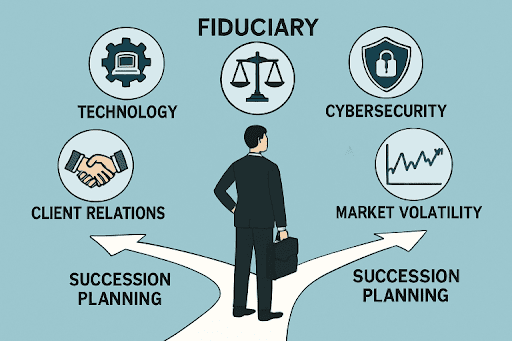Key Takeaways
- Technological advancements and digitization require fiduciaries to adopt innovations responsibly while protecting against new risks.
- Regulatory and market environments are evolving rapidly, demanding continuous adaptation and compliance from fiduciaries.
- Cybersecurity, market volatility, client expectations, and succession planning are critical ongoing challenges for fiduciaries navigating today’s landscape.
Introduction
The financial services industry is undergoing seismic changes driven by technology, regulatory upheavals, and shifting market dynamics. For fiduciaries, these changes represent both opportunities to improve service and efficiency and serious risks that must be actively managed.
Staying relevant in this quickly evolving environment requires more than familiarity with new tools and policies; it demands a proactive stance on innovation, risk mitigation, and client engagement. The convergence of artificial intelligence, big data, and new modes of client interaction means that every decision can have far-reaching effects.
Trust, transparency, and adaptability are becoming increasingly important as client needs and preferences rapidly evolve. Fiduciaries must now address complex ethical issues, rethink traditional approaches, and proactively embrace diversity in their service offerings and leadership.
Regulatory Compliance
Rapid innovation often outpaces regulation. The financial industry is constantly scrutinized and subject to changing rules from both domestic and international agencies. Recent legal shifts, such as the US judge’s blocking of the Department of Labor’s “Retirement Security Rule,” highlight how quickly compliance requirements fluctuate and require immediate operational adjustments.
Ongoing education, robust compliance monitoring, and legal partnership are required to avoid enforcement actions and costly missteps. Establishing internal teams or leveraging technology to monitor regulatory activity ensures fiduciaries remain compliant and well-prepared for future rule changes.
Cybersecurity Threats
The increased use of cloud-based platforms, remote work, and digital communications has heightened exposure to cyberattacks, data theft, and ransomware. Sensitive financial data is a prime target for hackers, making cybersecurity investment non-negotiable.
Proactive Risk Management
Best practices include encrypting data at rest and in transit, conducting regular penetration testing, and providing comprehensive security training to every team member. Having well-developed incident response plans and maintaining ongoing partnerships with cybersecurity firms is equally important.
Market Volatility
Economic instability and market swings demand agility from fiduciaries and strategies tailored to both short-term disruptions and long-term growth. Portfolio diversification among asset classes and geographies can act as a buffer to volatility, but it’s also crucial to communicate clearly with clients to prevent reactive investment decisions in volatile times.
Data-driven asset allocation and tools that allow real-time market analysis are essential. Strategies such as scenario planning and stress-testing portfolios can reveal vulnerabilities and aid in preemptive adjustment.
Client Expectations
Modern clients expect rapid responses, full transparency, and a seamless digital experience. They also want personalized financial advice, ethical practices, and access to their accounts via digital platforms. Meeting these expectations requires a robust investment in technology and a commitment to high-touch, customized service.
Personalization and Trust
Fiduciaries must foster trust by offering clear, jargon-free explanations and regular performance updates. Leveraging client feedback to refine services and proactively offering new digital options will improve satisfaction and retention, especially among younger, tech-savvy investors.
Succession Planning
Sustainable success requires a plan for leadership transition. Succession planning shouldn’t be viewed as a future concern; rather, it is a vital aspect of risk management and organizational continuity. Establishing formal protocols for talent identification, mentoring, and leadership training helps preserve institutional knowledge and maintain client confidence during periods of change.
Organizations should prioritize diversity in leadership development and create contingency plans to cover unforeseen departures. A living, adaptive succession plan signals resilience and readiness to clients, partners, and regulators.
Final Thoughts
The landscape for fiduciaries is more dynamic and multifaceted than ever before. By balancing innovative adoption with robust controls, remaining proactive in compliance, fortifying cybersecurity measures, and strengthening client relationships, fiduciaries can thrive in uncertainty. Foundation-building in succession readiness will ensure continued trust and performance, even as the pace of change accelerates. Continued learning and engagement with industry resources, such as those published by Barron’s, remain invaluable for professional growth and strategic advantage.



































